Author: Cade Jobe
IPA is a style known for showcasing pungent hop character, which is accomplished in part by huge dry hop additions. Some commercial brewers boast using upwards of 4 lbs/bbl (2 oz/gal; 15 g/L) in their IPA, though a few homebrewers push it even higher than that. Considering the cost of hops, particularly the most sought after varieties, as well as the yield lost to so much vegetative matter, these usage rates have an undeniable impact on the bottom line for each batch. Is it really worth it?
Dr. Tom Shellhammer, hop science expert from Oregon State University’s Department of Food Science and Technology, has led research looking into the impact various dry hop quantities have on beer aroma and flavor. Dr. Shellhammer’s team ran an experiment comparing beers with dry hop rates ranging from a low of 2 g/L (0.28 oz/gal; 0.5 lbs/bbl) to a high of 16 g/L (2.14 oz/gal; 4 lbs/bbl) then analyzed the objectively measurable and organoleptic effects. Ultimately, it was concluded that dry hop rates higher than 8 g/L (1.1 oz/gal; 2.1 lbs/bbl) is an “inefficient use of raw materials,” which is believed to be due to saturation of hop oils in the beer.
Brülosophy contributor Ray Found conducted an xBmt comparing dry hop rates of 2.9 g/L (0.4 oz/gal; 0.78 lbs/bbl) to 8.7 g/L (1.2 oz/gal; 2.2 lbs/bbl) that yielded significant results, indicating higher dry hop rates have a perceptible impact. Considered in light of the previously discussed experiment findings, our results aren’t surprising, as one batch was made with a dry hop quantity lower than the suggested saturation threshold while the other was made with a quantity just over said threshold. Curious to more specifically explore Dr. Shellhammer’s conclusion, I designed an xBmt to compare beers dry hopped with different quantities where both received an amount higher than the suggested saturation point.
| PURPOSE |
To evaluate the differences between an IPA dry hopped at a rate of 10 g/L (1.34 oz/gal; 2.6 lbs/bbl) and the same beer dry hopped at a rate of 15 g/L (2 oz/gal; 3.9 lbs/bbl).
| METHODS |
Having heard many good things about it, I went with an adapted version of MACC IPA for this xBmt.
Triple Stamp A Double Stamp IPA
Recipe Details
| Batch Size | Boil Time | IBU | SRM | Est. OG | Est. FG | ABV |
|---|---|---|---|---|---|---|
| 5.5 gal | 60 min | 75.8 IBUs | 5.3 SRM | 1.070 | 1.019 | 6.9 % |
| Actuals | 1.07 | 1.011 | 7.9 % | |||
Fermentables
| Name | Amount | % |
|---|---|---|
| Pale Malt (2 Row) US | 12.5 lbs | 89.29 |
| Munich Malt - 10L | 1.5 lbs | 10.71 |
Hops
| Name | Amount | Time | Use | Form | Alpha % |
|---|---|---|---|---|---|
| Magnum | 17 g | 60 min | First Wort | Pellet | 12.6 |
| Citra | 56 g | 15 min | Aroma | Pellet | 13.9 |
| Amarillo | 50 g | 15 min | Aroma | Pellet | 8.8 |
| Mosaic (HBC 369) | 50 g | 15 min | Aroma | Pellet | 11.7 |
| Centennial | 20 g | 15 min | Aroma | Pellet | 10.2 |
| Amarillo | 70 g | 5 days | Dry Hop | Pellet | 10.2 |
| Citra | 70 g | 5 days | Dry Hop | Pellet | 13.9 |
| Mosaic (HBC 369) | 70 g | 5 days | Dry Hop | Pellet | 11.7 |
Yeast
| Name | Lab | Attenuation | Temperature |
|---|---|---|---|
| Independence (A15) | Imperial Yeast | 74% | 60°F - 72°F |
Notes
| Water Profile: Ca 89 | Mg 17 | Na 38 | SO4 138 | Cl 50 |
Download
| Download this recipe's BeerXML file |
I started off this brew day by collecting water, adjusting it to my desired profile, then putting it over a flame to heat up.
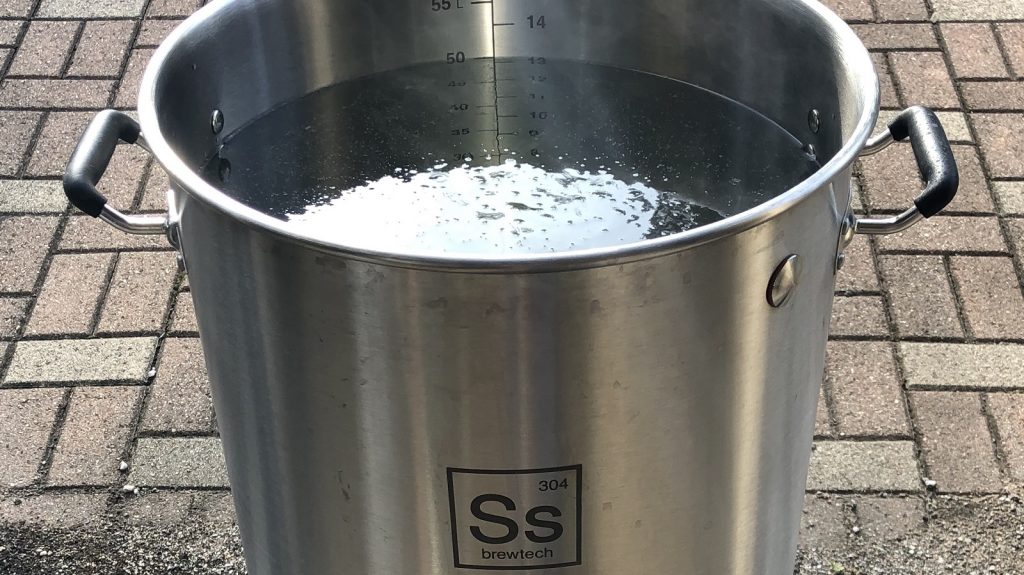
Next, I weighed out and milled the grain.
Once the water was appropriately heated, I incorporated the grains then checked to ensure I hit my target mash temperature.
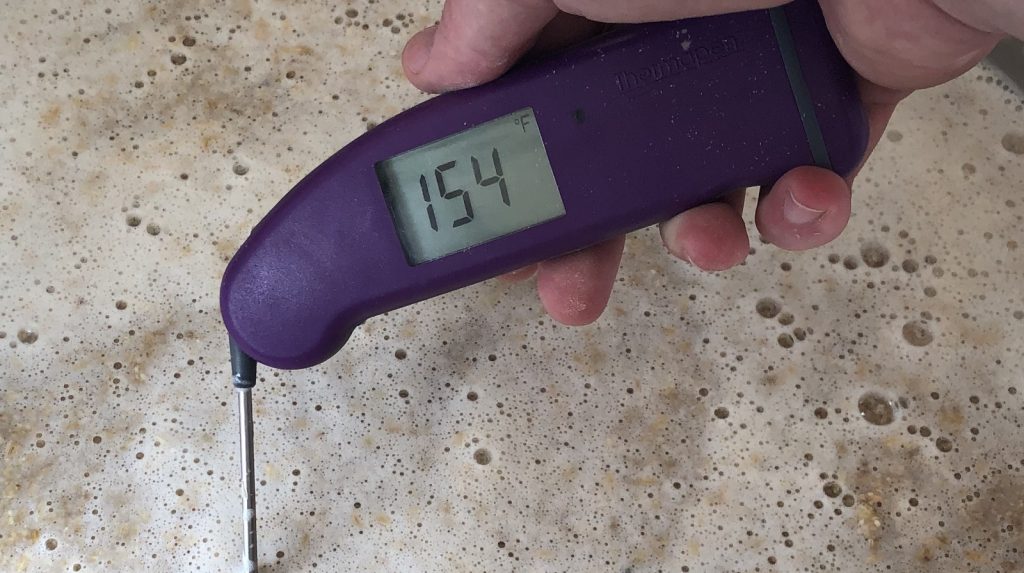
During the mash rest, I measured out the kettle hop additions.
When the 60 minute mash was complete, I fly sparged to my pre-boil volume then boiled the wort for another 60 minutes before chilling it with my IC.
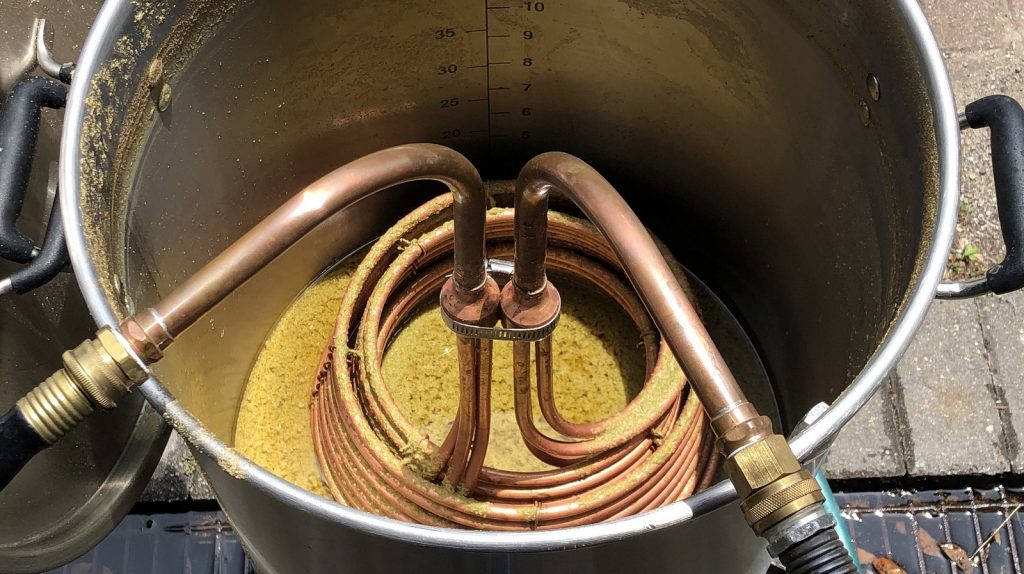
A refractometer reading showed the wort was right at the expected OG.
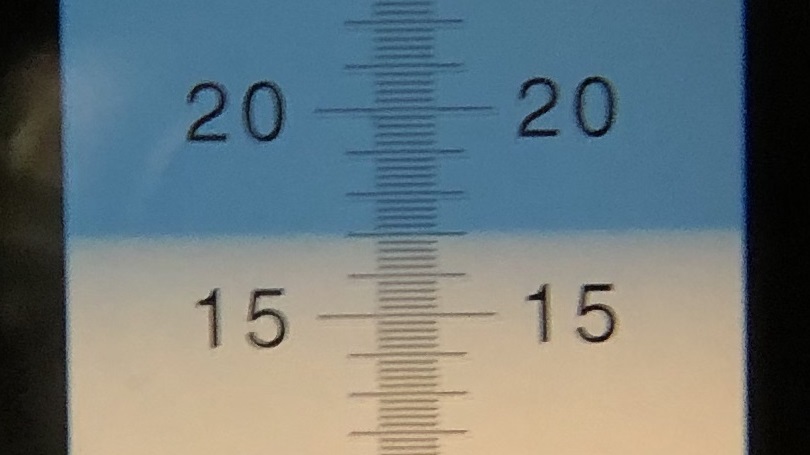
I then transferred equal amounts of chilled wort to identical Brew Buckets that got placed in my temperature controlled chamber. Once the worts had stabilized at 66°F/19°C, I pitched a single pouch of Imperial Yeast A15 Independence into each.
After 5 days of fermentation, I made the dry hop additions, one receiving 7.5 oz/210 g while the other was hit with 11 oz/312 g, both containing the same ratio of the different hop varieties.
I let the beers sit for 2 days before ramping the temperature in the chamber to 72°F/22°C. After another 5 days, both beers were sitting at the same 1.011 FG, so I proceeded with cold crashing and packaging under pressure to avoid oxidation. The beers were burst carbonated overnight before I reduced the gas to serving pressure where they were left to condition for 5 days before being served to tasters.
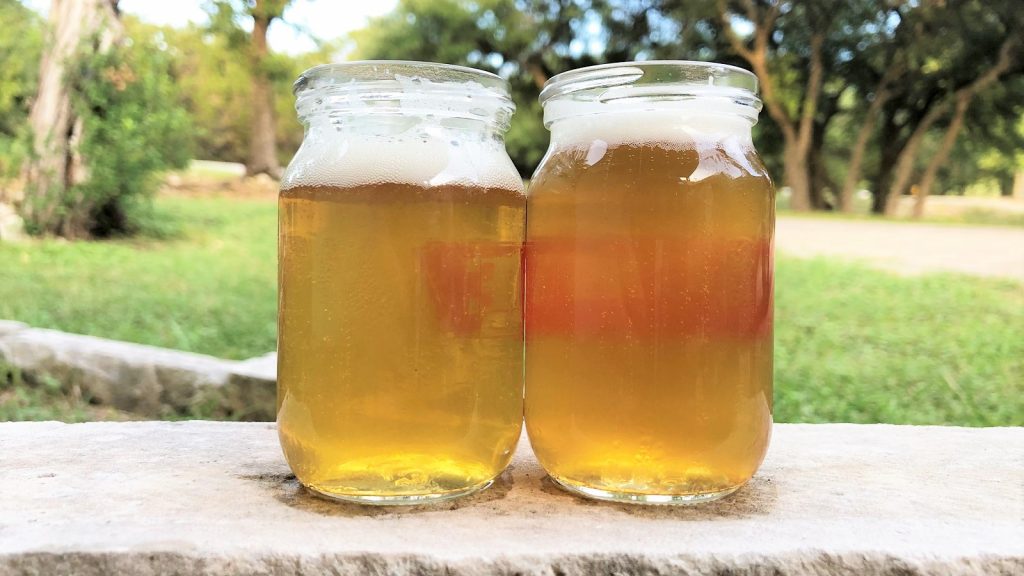
| RESULTS |
A total of 28 people of varying levels of experience participated in this xBmt. Participants were served 2 samples of the beer dry hopped at 10 g/L (1.34 oz/gal; 2.6 lbs/bbl) and 1 sample of the version dry hopped at 15 g/L (2 oz/gal; 3.9 lbs/bbl) in different colored opaque cups then were asked to identify the unique sample. While 15 tasters (p<0.05) would have had to identify the unique sample in order to reach statistical significance, only 13 (p=0.10) made the accurate selection, indicating participants in this xBmt could not reliably distinguish an IPA made with a 7.4 oz/209.4 g dry hop charge from one made with an 11 oz/311.8 g dry hop charge.
My Impressions: Out of the 3 semi-blind triangle tests I attempted, I identified the odd-beer-out exactly 0 times. Even knowing the variable and having brewed these beers, I could not tell them apart. The beers tasted and smelled identical to my senses, which wasn’t a bad thing because they were quite tasty!
| DISCUSSION |
The concept of a dry hop saturation point as proposed by Dr. Shellhammer’s research team flies in the face of the commonly accepted idea that more is better, which on the surface, seems to make some sense. While their experiment results and reasons they provide are quite convincing, dry hop dogma runs deep, making it all the more difficult to break away from what we “know.” Supporting Dr. Shellhammers claims, tasters in this xBmt were unable to tell apart beers dry hopped at different rates when both received quantities higher than the suggested dry hop saturation point.
There are a couple of pretty big implications of these findings. First, hops aren’t cheap, so any opportunity to cut back in a way that doesn’t impact beer quality is undeniably beneficial, regardless of whether one is a professional or homebrewer. Also, there’s a negative correlation between dry hop amount and final beer yield– as one goes up, the other goes down. As such, by reducing dry hop quantity, a brewer will likely increase the volume of beer from each batch, meaning more for the homebrewer to drink and more money for the commercial brewer to make.
As a science guy, I didn’t necessarily doubt Dr. Shellhammer’s findings, but even so, the fact an IPA hit with nearly 4 oz/113 g more dry hops was indistinguishable from the same beer made with less dry hops was pretty surprising to me. While both beers tasted great, I’ll be sticking with dry hop rates at or under the 8 g/L dry hop saturation point recommended by Dr. Shellhammer, as it seems the most economical option.
Note: The term “dry hop saturation point” is used in this article to explain Dr. Shellhammer’s empirically based concept that dry hopping at a rate higher than 8 g/L leads to diminishing returns.
If you have any thoughts about this xBmt, please do not hesitate to share in the comments section below!
Support Brülosophy In Style!
All designs are available in various colors and sizes on Amazon!
Follow Brülosophy on:
FACEBOOK | TWITTER | INSTAGRAM
If you enjoy this stuff and feel compelled to support Brulosophy.com, please check out the Support page for details on how you can very easily do so. Thanks!

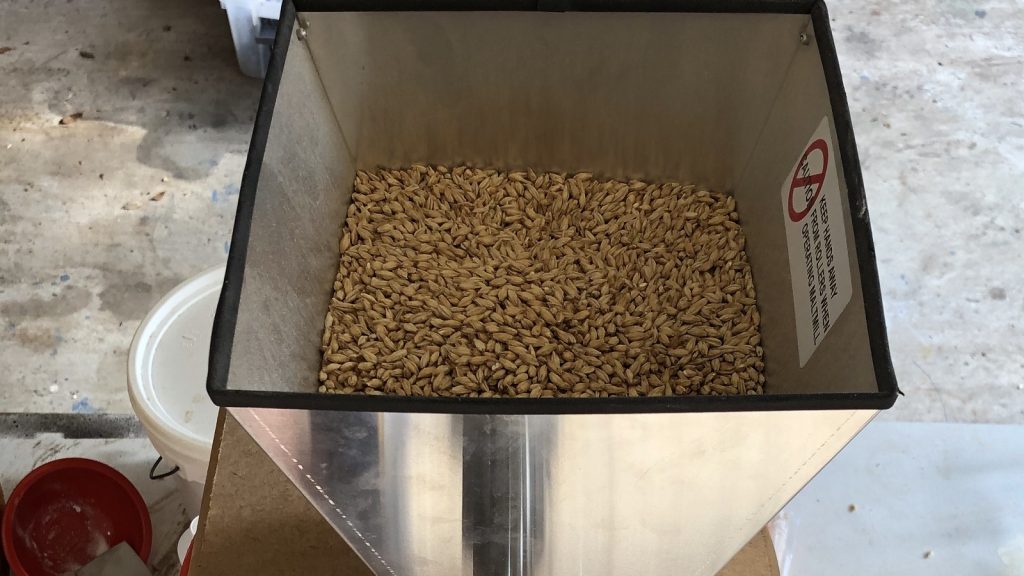

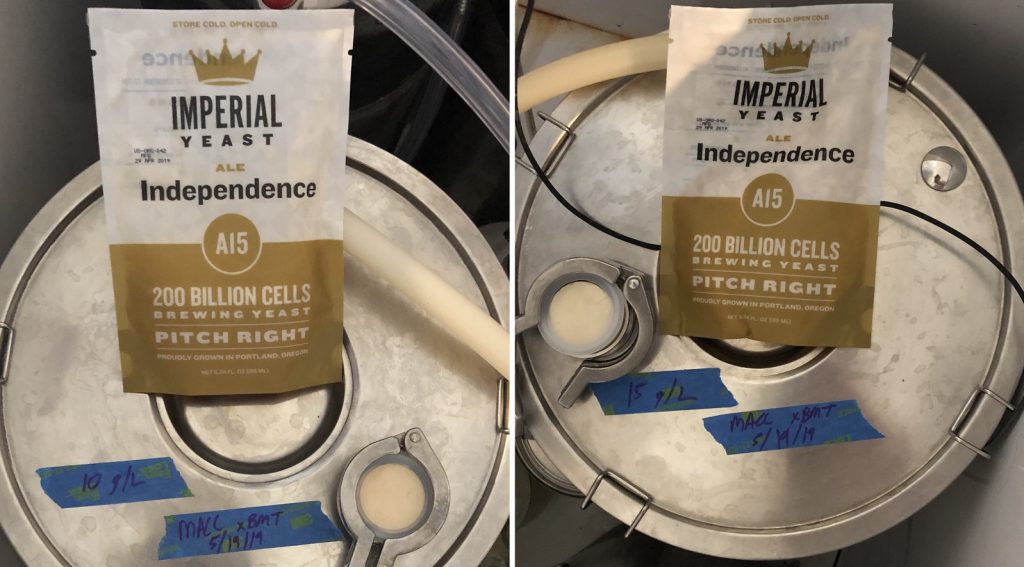
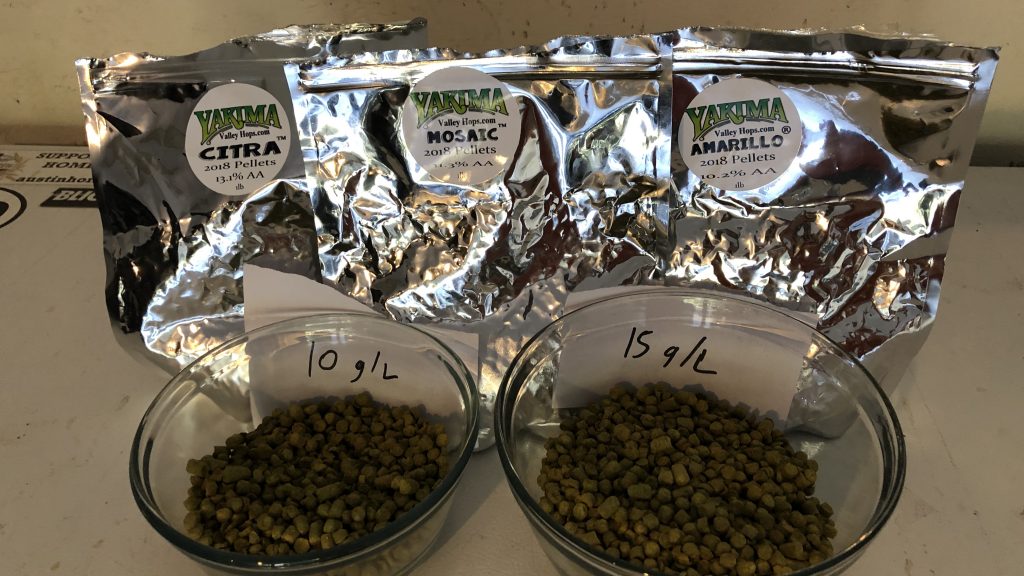










36 thoughts on “exBEERiment | Investigating The Dry Hop Saturation Point”
Cheers mate!
I read the study from Dr. Shellhammer a while back and was pretty surprised obviously. I kept my DH additions under 8g/L since and it has indeed saved me quite a bit of money for the same end result! Very nice to read that your exBEERiment shows the same conclusion.
Excellent test. Thanks
Looks like you dry hopped for 7+ days. Any consideration to decreasing that time? Research from Shelhammer’s group suggests 1 day is sufficient and longer times actually decrease hop oil extraction!
P. H., M. Q., & T. S. (2012, August 7). The Effect of Pellet Processing and Exposure Time on Dry Hop Aroma Extraction.
Retrieved from:
http://ir.library.oregonstate.edu/xmlui/bitstream/handle/1957/34093/Wolfe_thesis.pdf
Interesting. I haven’t read through that paper, but Marshall did a similar xBmt a while back which came back significant on a beer that was dry hopped for 2 days vs 11 days: https://brulosophy.com/2015/10/26/dry-hop-length-long-vs-short-exbeeriment-results/. If you’re interested, this could be a good one for you to try as a Brü Club repeat xBmt!
Significant, yes. But can you interpret whether the data indicates more or less “hoppyness” was in the long dry hop beer?
If I had 10 gal fermentation capabilities, I’d take up that offer!
Awesome experiment! This matches my own experience with large single doses of hops not providing quite the impact I was looking for. Anecdotally additional doses of dry hops added to the keg on top if a “saturation-level” sized dose in the fermenter does seem to provide an additional boost ime. I wonder if the large hop addition was split into 2 additions if it would have been discernable? Marshall did a single vs ddh xbmt a while back where he did 5oz at once vs 2.5oz twice which turned out insignificant. But now I wonder if it would be significant if the ddh batch recieved additional hops instead of the same amount split in half. Or maybe even additional hop varieties in the 2nd dryhop to introduce different aromatic compounds…. lots to think about… thanks!
Based on these results and Dr. Shellhammer’s studies, I’d be skeptical that adding a keg charge or splitting into 2 would make a meaningful difference. I’m not a scientist but it seems to me we’re talking about the solubility of a mass of hop (oils) in a volume of beer. If you get to 8-10 g/L of dry hops, I’m not sure the timing would make much of an impact. Who knows, though? That’s just my guess. Maybe we could tweak it slightly and try it again in the future.
If you are dry hopping with multiple hop varieties, then you would still be limited in the total amount of hops, right? For example, dry hopping an oz per gallon of both mosaic and citra for combined total of 2 oz per gallon would be beyond the limit, right?
So how to decided which hop and amount make the dry hopping cut? Also, how does the Alpha Acid content affect this limit?
An obvious question that follows is whether that amount of dry hops equates to a total saturation point for all hops added, in other words would 8g/L dry hop as the only flavor addition be different than 8g/L plus 4 oz late addition boil hops or flameout hops or whatever.
Interesting experiment but I wonder how this translates in a commercial setting? Would pressurised dry hopping shift the saturation point for example? Interestingly, Cloudwater Brewery in the UK displays their dry hop rates on their packaging. The dry hop rates are 8g/l for a Pale Ale, 16 g/l for a DDH (Double dry hopped) Pale Ale, 12 g/l for a DIPA and a whopping 24 g/l for a DDH DIPA. In my experience, the DDH versions are noticeably more hop forward!
Thanks! More hop exbeeriments!!! 🙂 Those beers are super clear for that many hops! Would you guys be willing to do a biotranformation vs soft-crash hopping exbeeriment? Janish’s new IPA book mentions soft crashing several times, and I have done some tests with it with mixed results. So, one would get the usual biotransformation dry hop and then the second one wouldn’t be dry hopped until it is fully fermented out and then crashed to 58-60F for a couple days to crash most of the yeast out. Then, dry hop like 2 days or so at 60F and crash. I’ve noticed huge mouthfeel and head retention using this method, but the beers seem to taste different in terms of hop character. Still need to do my own side by side.
What kind of mixed results are you talking about?
Also for the exbeeriment it would be interesting to do a similar one but with a new england protein rich grist to see if that makes a difference for packing more hops in one beer.
Actually, I did split batch IPA and did both with hops added only at soft crash (after the boil.) The galaxy batch is delicious. The citra batch has a strong perfume/floral note I’m not fond of. However, I keep forgetting that I really added a ton of hops to the citra version. It had 5 oz citra cryo and 1 oz T90 CTZ in 4.5G of wort! I’m doing another split batch right now, half with biotransformation dry hop and half with soft crash dry hop. Both 100% galaxy or close to it with 6 oz of T90 in each (1.33 oz/gal hopping rate.)
Interesting ! Any available article online or is it just in Janish book?
Cheers!
I’ll have to look and see if there are any articles. He mentions it in passing several times in the book though and pro brewers use it. I suppose they started doing it to harvest yeast and then realized it works well for dry hopping too.
This is great, thanks for running this. I always believed Shellhammers findings but was interested in the effect of over 8g/l after storage for prolonged periods. Maybe higher charges can prolong flavour retention. Would be interested to see a comparison
I’m curious if you measured the yield difference in the two batches?
I did not make a formal measurement, but there was easily an extra 0.5 gallons left in the fermenter of the 15 g/L batch due to hop material. It was painful transferring from both batches under pressure, but the 15 g/L batch was a nightmare.
Is it possible the heavy dosed beer’s hop profile would hold up better, ie saturation or perception? If the high load beer has a higher oil load but we cannot perceive it maybe over time it will hold up better – kind of a ceiling effect.
It’s worth noting that the Shellhammer work used Cascade, and it’s possible that the threshold will be different for other varieties depending on what chemicals their flavour depends on. One can imagine that the thresholds will be higher for varieties that eg depend more on thiols for their flavour.
I also wonder if a 3% total oil galaxy beer would follow the same pattern as a 1.5% oil cascade. Would the galaxy beer saturate twice as fast or is the perception influenced by other hop fractions.
It would be interesting to see if this “saturation point” increases with increased ABV. That would explain why a higher ABV beer seems to need a bigger dry hop dose in commercial beers like them from Cloudwater
Thank you for sharing this! I’ve been wondering the same thing about the whirlpool hop addition amounts. Would a similar rate of about 1 oz per gallon in the whirlpool also be a saturation point?
Look like there’s a 90% chance the panel detected an actual difference.
“Look like there’s a 90% chance the panel detected an actual difference.”
No, that’s a very common and very incorrect interpretation of what a p-value means.
P values are calculated on the assumption that the null hypothesis is true (tasters did not detect a difference). Therefore it says nothing about the alternative hypothesis (tasters detected a difference). What the p = 0.1 means here is that If if the population as a whole could not detect a difference, 10% of studies will obtain the effect observed in this experiment or larger, because of random sample error.
In other words, the *only* question that P values answer is “How probable are these results if tasters cannot detect a difference?”
Let me put it this way, then: *If* the null hypothesis (“no difference”) is true, there was only a 10% probability of obtaining the observed, or more extreme, results.
“Let me put it this way, then: *If* the null hypothesis (“no difference”) is true, there was only a 10% probability of obtaining the observed, or more extreme, results.”
That’s right. And readers can decide for themselves if that is strong enough evidence to reject the idea that there is no difference.
Wonder if different flavoured hops would make a difference? E.g 8 g/lt of Saaz mixed with 8g/lt Galaxy and then 8g/Lt Simcoe. Each have different flavour characteristics. Spicy, Tropical, Piney. If after 8g/Lt hops become saturated – wonder which one would win out??
This might be connected to other things too. I know that a lot of breweries “kick” heavily dry hopped beers with CO2 more than 10 times a day just to move them out of suspension and for normally dry hopped beers they do not to that. I would be interesting to test same beer where one is being “kicked” and another not.
Do the same rules apply when brewing a 10% Triple IPA? Or can higher hopping levels be beneficial.
In my experience, dry hopping near and beyond the 4lb/bbl mark mark requires recirculation, constant rousing, or significant yeast activity to realize the benefits of such a high dry hop. The benefit in aroma/flavor is typically small, but the benefit in longevity of flavor/aroma can be significant.
After listening to the Pod Cast I had some additional thoughts: given that Citra, Mosaic, Amarillo, and Centennial all have total oils > than cascade (Amarillo can be an exception depending on the lot), I would expect the saturation point (total weight of hops) to be lower and the effect of herbal/Tea to be pushed out. Put another way, I’m thinking hop aroma/flavor saturation is a function of oil weight, while herbal/tea characteristics are a function of total hop weight and the ratio of hop oils to total hop weight (I think high levels of oils per weight of hops would tend to mask some level of the herbal/tea effect. A few additional co-variants to control for. Given all this I would think that both beers would be saturated.
I looked at some older hop oil profile data* I had (2012 ish) and the average oil content for cascade was .8 ml per 100 grams (average alpha was 5.75%) compared to the CMAC (assuming equal %s) was 1.45 ml/100 grams (average alphas for the blend was 12.25%). Given this the scale amounts based on total oil concentrations would be 5.5 g/l vs 10 and 8.8 g/l vs 16. Looked at from another point of view, the 10 g/l of CMAC has 13% more oil than the 16 g/l of cascade (here’s the math: ( (10 * 1.45)/(16*.8)-1) * 100)
*Collected from various hop data sheets, oils included: myrcene, caryophyllene, humulene, and farnesene.
It’s true that beers can reach a saturation point where more hops contribute nothing more to a fresh beer. Try them after a month though and the difference is huge.
Can somebody answer a beginner’s question? In the experiment the higher dry hopping rate was 15g/litre. Were these hops in pellet form? – if so , what would be the equivalent ratio for hops picked straight off the plant and put in the fermenter?
I know this is an old post but this topic just came up with colleagues. Correct me if I’m wrong, but wasn’t Dr Shellhammer’s research based on static dry hopping, which doesn’t involve actively mixing the pellets? At work we have a “rolec”, which has a pump with a grinder. Hops are directly mixed into the beer then pumped through the racking arm and back into the rolec through the yeast dump port, and occurs for a minimum of four hours, before being left for a couple days. Is this sort of mixing taken into consideration, compared to just putting the hops on top of the krausen and leaving them to it?
Yes, Lafontaine and Shellhammer’s research was solely focused on static dry hopping, which as you suggest doesn’t involve any mixing, rousing, or agitation. There’s a lot of evidence that rousing/agitating increases the extraction rate, but I think there’s still a question of whether you hit a solubility limit. Scott Janish makes a great comment about agitation: “Dry hopping is entirely dependent on local diffusion speeds. Anything that speeds up diffusion (stirring, temperature, etc.) will speed up extraction rates.” https://scottjanish.com/dry-hop-best-practices-using-science-as-a-guide-for-process-and-recipe-development/. The key here is extraction rates vs extraction limits. You might get to a saturation point faster by rousing or agitating, but you might still reach the same point. In theory, of course. A brief google scholar search didn’t turn up any research on agitation and saturation. It would be interesting to see a study about this!